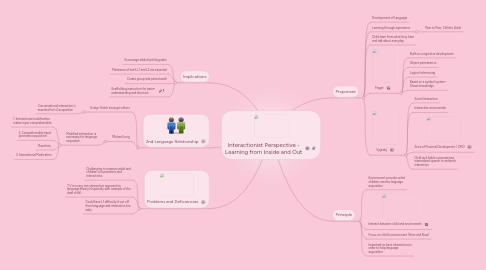Interactionist Perspective - Learning from Inside and Out
저자: Chantel Aarssen


1. Implications
1.1. Encourage addictive bilingualim
1.2. Maintance of both L1 and L2 are essential
1.3. Create group and paired work
1.4. Scaffolding instruction for easier understanding and direction
2. 2nd Language Relationship
2.1. Evelyn Hatch amongst others
2.1.1. Conversational interaction is essential for L2 acquisition
2.2. MIchael Long
2.2.1. Modified interaction is necessary for language acquisiton
2.2.1.1. 1. Interactional modification makes input comprehensible
2.2.1.2. 2. Comprehensible input promotes acquisition
2.2.1.3. Therefore,
2.2.1.4. 3. Interactional Modication
3. Problems and Deficiencies
3.1. Challenging to measure adult and children conversations and interactions
3.2. T.V is a very non-interactive approach to language theory( Especially with example of the deaf child)
3.3. Could have L1 difficulty if cut off from language and interaction too early
4. Proponent
4.1. Development of Language
4.2. Learning through experience
4.2.1. Peer to Peer, Child to Adult
4.3. Child learn from what they hear and talk about everyday
4.4. Piaget
4.4.1. Built on conginitive development
4.4.2. Object permanence
4.4.3. Logical inferencing
4.4.4. Based on a symbol system- Shows knowledge
4.5. Vygtsky
4.5.1. Social Interaction
4.5.2. Interactive environemtn
4.5.3. Zone of Proximal Development ( ZPD)
4.5.4. Child and Adult conversations, internalized speech to enhance interaction
